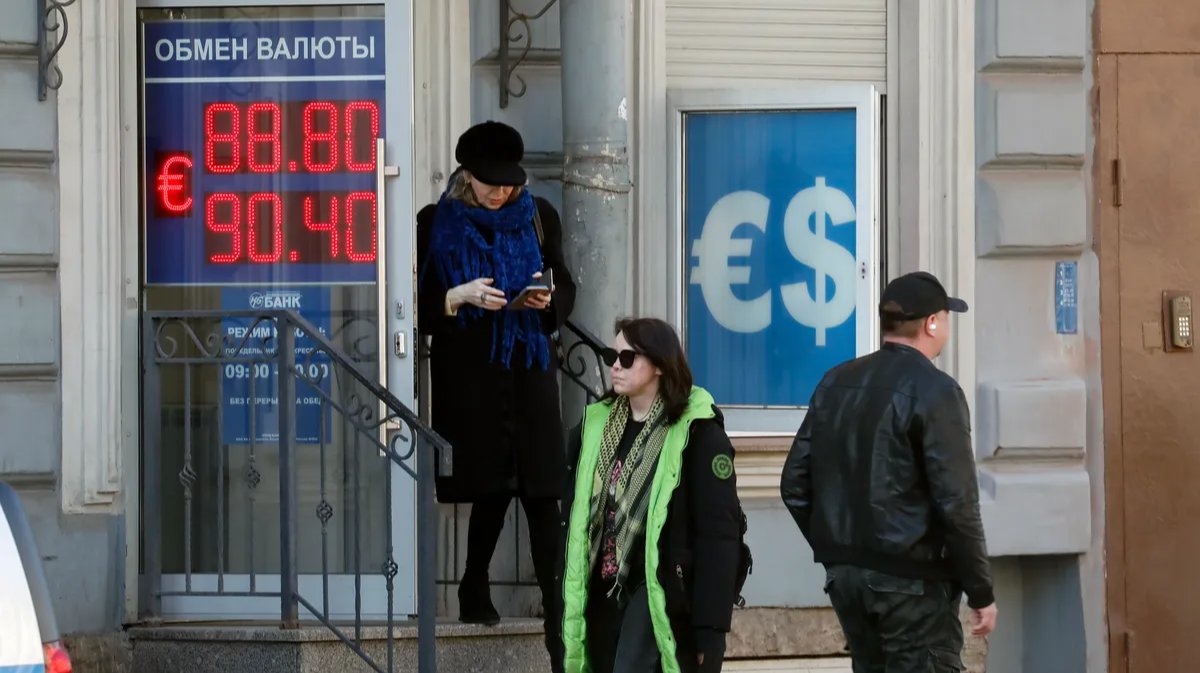The ruble, the national currency of Russia, has been depreciating the whole week. At midday on Friday, the dollar was trading at 83 rubles, the euro — 91 rubles. These are the lowest values that the ruble has hit since last spring when Russia’s invasion of Ukraine was just beginning. At the time, the currency markets were in full-blown panic, the dollar soared to 130 rubles, while the exchange rate fluctuations reached 10% a day.
There are now far fewer causes for worry. Following the OPEC+ decision to cut oil production, the Brent crude price rose to $85, a comfortable price for Russia. Even though sanctions dealt a blow to Moscow’s fuel revenues, Russia’s trade balance still looks decent. Russian oil has found new customers in China, India, and Turkey.
What lurks behind the ruble’s free fall then? As usual, the exchange rate is affected by a multitude of factors: export and import dynamics, the tax year end, foreign companies selling their assets in Russia, the difference between interest rates set by the Federal Reserve System and the Russian Central Bank, the Finance Ministry’s reduced currency selling rates, and so on. We will not delve into these technicalities and will focus on the general scope of the situation.
The first thing worth mentioning is that
the dollar has been getting stronger since the autumn when the exchange rate stood at 60 rubles even though the drop has sped up in the last few weeks. The ruble has shed almost 40% of its value since September.
What we are seeing now is largely a return to equilibrium levels after a period of the unnaturally strong ruble.
Last summer, the combination of windfall export revenues and a total collapse of imports oversaturated the market with currencies. As the year came to a close, both factors died down: the EU imposed an embargo and a price cap for Russian oil, while imports recovered due to supplies via “friendly countries”. Trade flows recovered and the ruble is now once again affected by the same metrics as before.
With one crucial note. Following the financial tribulations of 2022, the ruble is currently trading on a “thin market”. It means that the number and volume of currency transactions have significantly dropped and now even a small change in supply or demand can substantially affect the exchange rate.
The number of dollar transactions on the Russian stock exchange has shrunk by 2-3 times since the beginning of 2022. There are almost no non-residents left in the country and they used to have a large influence on the market. The share of export payments in dollars and euros has contracted from 87% to 48%, this niche was filled by the ruble and the yuan.

Volkswagen car plant in Russia’s Kaluga. Photo: Volkswagen Group
There are practically no foreigners on the market, while an increasingly bigger share of the trade is conducted in yuans. There is virtually no place where the “toxic currencies” (the dollar and the euro, of course) can be obtained. The market has shallowed and its liquidity has decreased manyfold.
Back in the day, Russia’s oil giant Rosneft could buy foreign currencies worth 625 billion rubles (€7.06 billion) to send the exchange rate plummeting. The ruble has become much shallower since then and today a nosedive can be caused by far less important news. For instance, the current round of devaluation was caused by a recent deal done by Shell to sell its share in the Sakhalin-2 oil and gas development project worth 95 billion rubles (€1.07 billion).
Indeed, this is not the only deal fraught with capital withdrawal: Russia’s foreign investment commission can soon greenlight the sales of Hyundai’s and Volkswagen’s businesses in Russia. In total, around 2,000 Western companies are queuing to pull out of the sanction-riddled country. Naturally, they all would like to withdraw the money raised in these sales overseas.

A Sakhalin-2 project facility. Photo: Sakhalin Energy
The Shell development lays bare the new nature of the Russian currency market. Another symptom is the increasing dependency on the yuan. The Chinese national currency has been traded the most at the Moscow Exchange for two months running. The Russian Finance Ministry has been carrying out fiscal rule currency transactions in yuans, while the national Central Bank stores 60% of its reserves in this currency.
If this yuanisation continues at its current pace, Russians will soon need to forget about the dollar and switch to the Chinese currency rates.
However, it’s not all calm on the yuan front even though it is a “friendly” currency — capital flows are limited in China, while the exchange rates are effectively placed under government control. Therefore, most central banks that have the liberty of choosing opt against storing their reserves in yuans.
Experts are unanimous in their opinion that there are currently no reasons for the ruble to continue its rapid descent. Oil prices will remain high in April, while the national oil and gas revenues can return to its base level (used to draft the country’s budget) in May, particularly because the Finance Ministry will start calculating the Urals crude discount under a new formula.
On the other hand, some things never change, and the Russian budget still wins from the ruble’s gradual depreciation. So, a rollback to at least 75 rubles for $1 can be seen as largely a favourable scenario for Russia.
Join us in rebuilding Novaya Gazeta Europe
The Russian government has banned independent media. We were forced to leave our country in order to keep doing our job, telling our readers about what is going on Russia, Ukraine and Europe.
We will continue fighting against warfare and dictatorship. We believe that freedom of speech is the most efficient antidote against tyranny. Support us financially to help us fight for peace and freedom.
By clicking the Support button, you agree to the processing of your personal data.
To cancel a regular donation, please write to [email protected]

